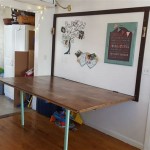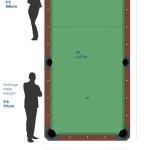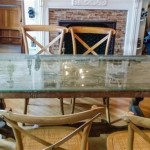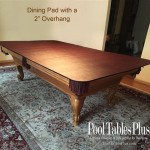What Are High Kitchen Tables Called?
The proliferation of diverse furniture designs has led to a variety of terms used to describe high kitchen tables. Understanding the correct terminology is essential for accurate communication when discussing kitchen layouts, furniture selection, and interior design concepts. High kitchen tables, often selected for their aesthetic appeal and functional benefits, are known by several names, reflecting slight variations in their design and intended purpose. This article delves into the common names for high kitchen tables, analyzes their defining characteristics, and explores the contexts in which each term is most appropriately used.
One of the most common terms used to describe high kitchen tables is "counter height table." This nomenclature is derived directly from the standard height of kitchen counters, which typically range from 34 to 36 inches. Counter height tables are designed to match this height, creating a seamless visual line when placed adjacent to or integrated with existing kitchen counters or islands. This consistency in height facilitates various kitchen activities, such as food preparation, informal dining, and social interaction. The term "counter height table" is widely recognized and readily understood by furniture retailers, interior designers, and consumers alike.
Another frequently used term is "bar height table." As the name suggests, bar height tables are taller than counter height tables, typically measuring between 40 and 42 inches high. This elevated height is analogous to the height of bars and pub tables, providing a more casual and social atmosphere. Bar height tables are often paired with bar stools, creating a comfortable and stylish space for drinks, appetizers, or casual meals. The increased height also offers an enhanced view and can create a more open and airy feel in the kitchen. Due to their increased height, bar height tables demand a larger space than counter height tables. Therefore, this is an important factor to consider when planning a kitchen design.
Beyond counter and bar height tables, the term "pub table" is also frequently encountered. While often used interchangeably with "bar height table," the term "pub table" typically implies a specific aesthetic. Traditionally, pub tables exhibit a more rustic or classic design, often featuring round tabletops, pedestal bases, and dark wood finishes. They evoke the ambiance of traditional pubs and bars, lending a warm and inviting atmosphere to the kitchen or dining area. Pub tables can effectively bridge the gap between casual dining and social gathering, making them a popular choice for those seeking a relaxed and convivial space.
It's crucial to differentiate these terms, as the height difference and design nuances can significantly impact the overall look and feel of the kitchen. Furthermore, understanding these terms assists in selecting the correct accompanying seating options, such as counter stools or bar stools, ensuring a comfortable and ergonomic dining experience.
Key Point 1: Distinguishing Counter Height Tables
Counter height tables, as previously mentioned, are characterized by their consistent height with standard kitchen counters, typically ranging from 34 to 36 inches. This uniformity allows for seamless integration with the existing kitchen layout. The primary advantage of counter height tables lies in their versatility. They can serve as an extension of the countertop, providing additional workspace during food preparation. They also function as informal dining areas, offering a convenient spot for quick meals or snacks. Furthermore, counter height tables facilitate social interaction, as individuals can easily engage in conversation while standing or sitting on counter stools. This height also is frequently convenient for individuals of differing heights, making it easier for several family members to use the space without discomfort.
The design options for counter height tables are extensive, ranging from minimalist contemporary styles to traditional farmhouse designs. The materials used in their construction vary widely, including wood, metal, glass, and laminate. The choice of material and design depends on the overall aesthetic of the kitchen and the desired level of durability. Counter height tables are generally paired with counter stools, which typically measure between 24 and 26 inches from the floor to the seat. It's essential to select counter stools that provide adequate back support and footrests to ensure comfortable seating.
Consider the dimensions of the available space when selecting a counter height table. A smaller kitchen may benefit from a round or square table, while a larger kitchen can accommodate a rectangular or oval table. Furthermore, consider the number of individuals who will typically use the table. A larger table may be necessary for families or those who frequently entertain guests. The positioning of the table is also a critical consideration. Counter height tables can be placed against a wall, integrated into a kitchen island, or positioned as a standalone piece in the center of the room. The placement should optimize the flow of traffic and maximize the functionality of the kitchen space. Furthermore, lighting should be considered to ensure optimal visibility for all activities.
Key Point 2: Understanding Bar Height Tables
Bar height tables, standing at 40 to 42 inches tall, offer a distinct aesthetic and functional appeal. Their elevated height creates a more casual and social atmosphere, reminiscent of bars and pubs. Bar height tables are often chosen for their ability to create a focal point in the kitchen or dining area. The increased height provides an enhanced view and can contribute to a more open and airy feel. Bar height tables are particularly well-suited for individuals who enjoy entertaining guests or those who prefer a more informal dining experience.
The design variations for bar height tables are similarly diverse, encompassing various styles, materials, and finishes. Bar height tables are frequently constructed from durable materials such as solid wood, metal, or a combination of both. The choice of material and design should complement the overall style of the kitchen and reflect the individual's personal preferences. Bar height tables are typically paired with bar stools, which measure between 28 and 30 inches from the floor to the seat. It's crucial to select bar stools that offer adequate back support and footrests to ensure comfortable seating for extended periods. Furthermore, the base of the table should be stable and well-balanced to prevent tipping or wobbling.
When selecting a bar height table, consider the available space and the intended use of the area. Bar height tables require more vertical space than counter height tables, so it's essential to ensure that there is sufficient headroom above the table. A smaller kitchen may benefit from a narrow or compact bar height table, while a larger kitchen can accommodate a larger and more elaborate design. The positioning of the table is also an important factor. Bar height tables can be placed against a wall, integrated into a kitchen island, or used as a standalone piece to divide the kitchen and dining areas. Strategic placement can help to define different zones within the kitchen and create a more functional and aesthetically pleasing space.
Key Point 3: Exploring the Nuances of Pub Tables
Pub tables, while often used synonymously with bar height tables, typically exhibit a more specific aesthetic characterized by a rustic or classic design. Traditionally, pub tables feature round tabletops, pedestal bases, and dark wood finishes. These design elements evoke the ambiance of traditional pubs and bars, creating a warm and inviting atmosphere. Pub tables are often chosen for their ability to blend casual dining with social gathering, making them a popular choice for those seeking a relaxed and convivial space. However, the specific characteristics of a pub table are not rigidly defined, and variations exist across different styles and designs.
The materials used in the construction of pub tables typically include wood, metal, or a combination of both. The choice of material often reflects the overall design style of the table. For example, a rustic pub table may feature reclaimed wood and wrought iron accents, while a more contemporary pub table may incorporate stainless steel or glass elements. The size and shape of the tabletop can also vary, although round tabletops are the most common. Pub tables are usually paired with bar stools or pub stools, which are specifically designed to complement the height and style of the table. The seating options should be comfortable and ergonomic, providing adequate back support and footrests for extended periods of use.
When selecting a pub table, consider the overall aesthetic of the kitchen or dining area. Pub tables can be a focal point in the space, so it's essential to choose a design that complements the existing furniture and décor. Consider the size and shape of the tabletop, as well as the height of the table, to ensure that it is appropriate for the available space. The positioning of the table is also a critical consideration. Pub tables can be placed against a wall, integrated into a kitchen island, or used as a standalone piece to create a dedicated social gathering area. The specific placement should optimize the flow of traffic and create a functional and aesthetically pleasing space.
In summary, high kitchen tables are commonly referred to as counter height tables, bar height tables, and pub tables. These terms, while sometimes used interchangeably, denote slight variations in height, design, and intended purpose. Understanding the nuances of each term is essential for effective communication and informed decision-making when selecting furniture for the kitchen or dining area. Careful consideration of the available space, the desired aesthetic, and the intended use of the table will ensure that the chosen option meets both functional and aesthetic requirements.

What Is Standard Counter Height Bar Table Wfmo

What Is Standard Counter Height Bar Table Wfmo

What Is Standard Counter Height Bar Table Wfmo

Counter Height Vs Bar Stools What S The Difference

Standard Dining Table Dimensions The Size Guide

Standard Dining Table Dimensions The Size Guide

Dining Room Tables Pottery Barn

Guide To Choosing The Right Stool Height Bar Counter Table Stools

5pcs Dining Table Set Faux Marble Counter Height Kitchen With Bottom Shelf And Matching 4 Pu Leather High Back Chairs For Room Small Space Com

The Complete Guide To Table Dimensions Bassett Furniture








